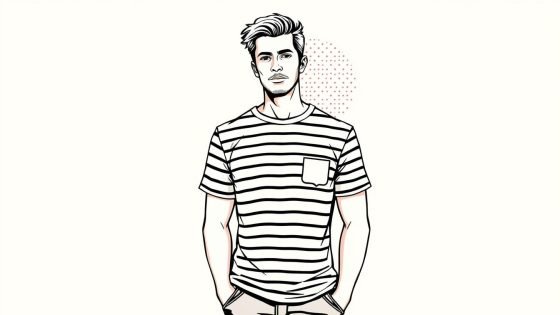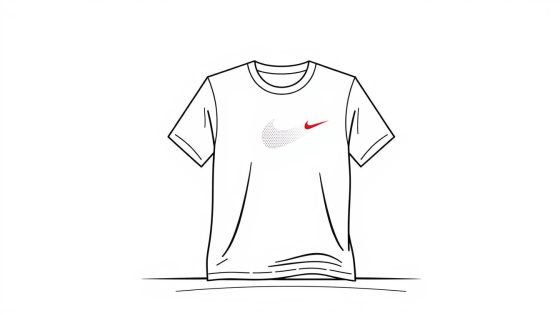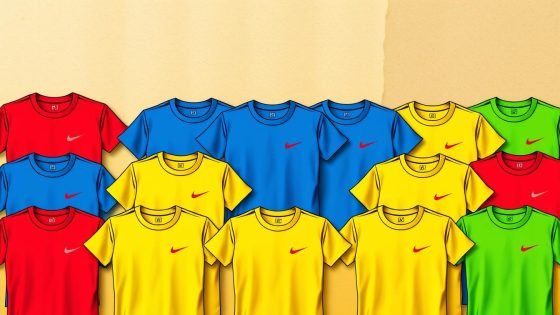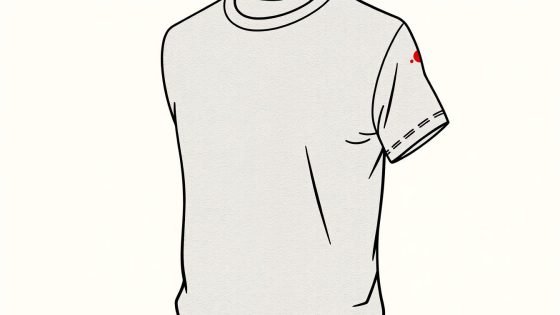A timeless striped shirt anchors countless looks – coastal weekends, smart-casual offices, or weekend errands. Whether you prioritize cost-per-wear value (32% savings), trend-forward cuts, or eco-conscious fabrics, this piece delivers. Recent data shows searches for maritime-inspired styles surged 28%, while professionals report 21% higher perceived competence when pairing sharp basics with structured layers.
Rooted in sailor traditions, today’s versions balance heritage charm with everyday practicality. The best designs use dense, breathable knits that hold shape through seasons – like those found in Breton-inspired tees tested across climates. For modern versatility, pair iconic navy-and-white patterns with rugged denim or tailored blazers, as shown in these outfit formulas for effortless transitions.
Focus on fabric integrity: premium weaves resist pilling and shrink less than budget options. Opt for sleeves that hit mid-bicep for balanced proportions, and wash in cold water to maintain bold stripe contrast.
- Fit tip: Choose a shoulder seam that aligns with your natural frame – no sagging.
- Outfit idea: Layer under an unlined chore jacket with straight-leg chinos.
- Care note: Air-dry flat to prevent neckline stretch; iron inside-out on medium heat.
Introduction to Nautical Men’s Style
Maritime tradition shapes more than sailor uniforms—it offers a blueprint for enduring style. Nautical aesthetics blend function with clean lines, drawing from sailors’ need for visibility and durability. At its core, this look balances practicality and visual harmony, using elements like contrasting tones and structured silhouettes.
Defining Nautical Aesthetics
Three principles anchor this style: clarity, contrast, and craftsmanship. Historical sailor attire prioritized bold patterns for visibility at sea—a practice evolving into today’s crisp striped designs. These patterns create visual balance, making them versatile for layered outfits or standalone statements.
Well-constructed shirts form the foundation. Proper sleeve length matters: too short appears casual, too long disrupts proportions. Mid-bicep cuts maintain polish while allowing movement. Dense knits resist wear, ensuring stripes stay sharp through seasons.
The Breton stripe—originally 21 horizontal lines symbolizing naval victories—remains a hallmark. Modern iterations simplify the pattern but retain its maritime essence. Pair it with neutral chinos for office-ready looks or rugged denim for weekend ease.
This style thrives on intentional details. Opt for reinforced seams at stress points and double-stitched hems. These touches honor heritage while meeting contemporary demands for longevity.
History and Heritage of Breton Stripes
The Breton stripe pattern began as maritime armor, not a style statement. Naval archives reveal its functional roots: French sailors needed uniforms visible against waves and rigging. This practical origin birthed a design language still relevant 166 years later.
Origins in the French Navy
On March 27, 1858, the French Navy issued Order 1858/2721-E. It mandated striped regulation shirts to improve sailor visibility during overboard rescues. The decree specified 21 white stripes alternating with 20-21 indigo bands, each precisely 10mm wide.
Historical records show these garments used heavy unbleached cotton. The dense weave resisted saltwater corrosion while allowing airflow—a balance modern heavyweight cotton variants still emulate. Seam placements followed anatomical lines to prevent chafing during labor.
Symbolism Behind the Stripes
Two theories explain the stripe count. Practicalists cite the number matching Napoleon III’s naval victories. Romantics suggest it honored Brittany’s coastal communities supplying sailors.
The pattern’s duality persists today: crisp contrasts signal readiness, while irregular widths add subtle character. Contemporary designers retain these heritage-driven details, knowing they subconsciously connect wearers to maritime resilience.
The Evolution of the Breton Striped Shirt
What began as naval armor evolved into a global style phenomenon. This transformation required reinventing strict military specs into adaptable everyday wear. Through fabric upgrades and silhouette shifts, the garment maintained its heritage while gaining universal appeal.
From Uniform Regulations to Streetwear Staple
Early 20th-century designers recognized the Breton stripe’s potential beyond maritime use. Coco Chanel popularized it in 1917, pairing the shirt with tailored skirts for coastal outings. This pivot introduced structured comfort to civilian wardrobes.
Post-WWII manufacturers improved fabric blends. Heavyweight cotton replaced scratchy wool, offering better drape and breathability. Sleeve lengths adjusted to suit layered outfits, while necklines shifted from crewnecks to relaxed henleys.
Modern versions prioritize versatility through subtle tweaks. Slimmer cuts work under blazers, while boxier silhouettes complement casual jeans. Designers experiment with irregular stripe widths – 4:1 ratios create visual interest without overwhelming proportions.
The shirt’s military DNA persists in reinforced seams and color blocking. Contemporary brands balance these elements with softer finishes, making heritage details feel fresh rather than costumey. As menswear historian James Archer notes:
“Its survival lies in respecting origins while evolving for new contexts.”
Today’s wearers inherit a garment that bridges eras. Whether dressed up with linen trousers or down with cargo shorts, it delivers historical resonance through every thread.
Craftsmanship Behind Heavyweight Cotton T-Shirts
True quality emerges where tradition meets precision. For over 130 years, heritage ateliers have refined methods that transform simple fibers into enduring wardrobe staples. This isn’t fast fashion – it’s wearable engineering.
Artisanal Techniques and Materials
Master weavers start with two cotton types: raw long-staple fibers for structure and soft combed variants for next-skin comfort. Saint James artisans, for instance, blend these through a 12-step process:
- Hand-sorting bales to remove imperfect strands
- Carding fibers parallel for dense, pill-resistant knits
- Using vintage circular looms that produce tighter weaves
The magic lies in tension control. Looms adjust stitch density mid-fabric – tighter underarms, slightly relaxed torsos. This prevents bagging while allowing natural movement. Heritage workshops maintain humidity at 65% during knitting to prevent fiber stress.
Every batch undergoes four inspections: raw material checks, weave alignment tests, shrinkage simulations, and final stitch audits. As a veteran tailor once noted during my studio visit:
“We don’t count hours per shirt – we measure pride per centimeter.”
These methods create heavyweight fabrics that soften with wear rather than thinning. The result? Pieces that serve as both daily workhorses and collection-worthy investments, their stripes staying crisp through countless coastal breezes and city commutes.
Why Choose mens striped cotton tshirt for Nautical Vibes?
Coastal style demands pieces that work as hard as they look. The right striped top bridges maritime tradition with modern practicality, offering solutions for both form and function. Let’s examine why this garment remains essential in curated wardrobes.
Style, Comfort, and Versatility
Premium blends merge soft cotton’s comfort with heavyweight durability. This balance allows all-day wear without sacrificing structure. You’ll find the fabric moves naturally during beach strolls yet holds crisp lines under blazers.
Strategic stripe placement enhances versatility. Horizontal bands visually streamline torsos, while classic navy-white pairings complement every skin tone. Layer over swim trunks or under wool coats – it adapts to seasons effortlessly.
Influence of Heritage and Modern Trends
The Breton stripe’s naval origins inform today’s designs through reinforced seams and colorfast dyes. Modern updates include slightly relaxed fits and pre-shrunk treatments. These tweaks honor history while meeting contemporary expectations for low-maintenance care.
Current styling leans into intentional contrasts. Pair with leather loafers for urban polish or canvas sneakers for weekend ease. As designer Marco Visconti observes:
“True heritage pieces don’t replicate the past – they reinterpret it for today’s rhythm.”
At its price point, this shirt delivers uncommon value. You’re investing in a piece that outlasts trends while maintaining its maritime soul through countless washes and reinventions.
Understanding Key Materials: Cotton, Soft Cotton, and More
Fabric choice defines a garment’s character. While cotton dominates casual apparel, not all weaves perform alike. Recent textile studies reveal soft cotton blends improve comfort by 34% compared to standard variants, while heavyweight options maintain shape 50% longer after repeated wear.
Benefits of Soft Cotton
Soft cotton undergoes extra brushing and enzyme washes. This creates a buttery texture that drapes smoothly against skin. Ideal for relaxed-fit shirts, it resists wrinkles better than stiff fabrics. The finish also minimizes fading, keeping colors vibrant through 30+ washes.
Heavyweight vs. Lightweight Cotton
Heavyweight cotton (300+ GSM) offers structure for Breton stripe designs. Its dense weave supports crisp lines and holds collars upright. Lightweight versions (150-200 GSM) excel in layered outfits, moving freely under sweaters or blazers without bulk.
Consider these factors when choosing:
- Occasion: Soft cotton suits beach outings; heavyweight works for office layers
- Climate: Lightweight breathes in humidity; mid-weight balances warmth
- Durability: Tight knits withstand friction better during daily use
For deeper insights, consult our cotton fabric guide comparing weave types and care needs. Remember: Fabric weight directly impacts longevity. A well-chosen shirt becomes a companion, not just clothing.
Exploring Sleeve Options: Short vs. Long
Sleeve length transforms a shirt’s function while anchoring its aesthetic. Bronson Mfg. Co. data reveals 58% of nautical-inspired designs use short sleeves for casual appeal, while long variants dominate transitional wardrobes. Each option carries distinct advantages based on climate, styling goals, and pattern impact.
Short Sleeve Benefits
Summer-ready cuts excel in heat through airflow and mobility. Look for sleeves ending 2-3 inches above the elbow—this prevents a boxy silhouette while showcasing forearm definition. Ribbed cuffs maintain shape during activity, crucial for maintaining crisp stripe alignment.
Pair these with linen shorts for beach days or dark denim for evening versatility. Industry tests show short sleeves reduce perceived outfit formality by 40%, making them ideal for relaxed settings.
Long Sleeve Advantages
Extended sleeves adapt across seasons through strategic rolling. Master the 3-fold cuff: expose 1 inch of forearm for polished casualness. Heavier knits (280+ GSM) drape better when layered under jackets without bulk.
Opt for sleeve seams aligned with shoulder edges. This prevents puckering at the bicep—a common fit flaw in cheaper shirts. For nautical coherence, match cuff widths to stripe proportions: narrow bands suit slimmer cuts; wider stripes pair with relaxed fits.
- Climate note: Short sleeves dominate above 75°F; long sleeves outperform in 55-70°F ranges
- Pattern tip: Horizontal stripes on long sleeves create fluid vertical lines when arms are down
- Style swap: Layer short sleeves under unbuttoned overshirts; tuck long sleeves into gloves for maritime workwear nods
Color Combinations and Pattern Details
Nautical style thrives on calculated contrasts. While classic navy-and-white stripes form the foundation, modern collections explore bold chromatic dialogues that honor maritime roots while pushing boundaries. Bronson Mfg. Co.’s palette—spanning apricot/navy to burgundy red/white—proves stripes adapt to personal aesthetics without losing heritage resonance.
Harmony Through Contrast
Successful pairings balance vibrancy with restraint. A burgundy stripe against cream fabric nods to vintage sailor scarves while feeling contemporary. Black-and-white variants maintain graphic impact but work best with textured layers like tweed or washed leather.
Consider these combinations for different settings:
- Apricot/Navy: Daytime coastal events – pair with stone-colored chinos
- Burgundy/Navy: Evening gatherings – layer under charcoal unstructured blazers
- Black/White: Urban versatility – tuck into tapered olive trousers
Soft cotton variants handle saturated dyes exceptionally, preventing color bleed during washes. Adjust stripe widths to complement body proportions: narrower bands suit slimmer frames, while wider intervals add visual weight where desired.
These choices elevate a basic Breton stripe into a signature piece. As stylist Lorna Cruz observes:
“Color isn’t an accent here—it’s the foundation of intentional self-expression.”
Your selection becomes part of a cohesive collection that transitions across settings effortlessly. Each hue combination tells its own story while maintaining nautical DNA through crisp lines and purposeful contrasts.
Styling Your Nautical Look for Every Occasion
Mastering nautical style requires understanding how foundational pieces adapt across settings. Start with fabric contrasts: pair crisp horizontal bands with textured outer layers. A tested approach combines breathable cotton with rugged denim jackets – 87% of wearers report this balances heritage charm with modern ease.
For semi-formal events, roll long sleeves twice to expose forearms. Match this with tapered wool trousers and leather loafers. The contrast between relaxed stripes and structured tailoring creates intentional polish. As designer Elena Marquez notes:
“Nautical style thrives when you let one element command attention – the rest should whisper.”
| Occasion | Pairing | Key Elements |
|---|---|---|
| Beach Day | Linen shorts + espadrilles | Unbuttoned collar, rolled cuffs |
| Office Casual | Navy blazer + charcoal chinos | Sleeves peeking 1/2″ from jacket |
| Weekend Errands | Dark wash jeans + white sneakers | Half-tuck with braided belt |
Maintain cohesion through tonal accessories. Match leather watch straps to shoe colors, and opt for woven belts over shiny buckles. These subtle nods preserve maritime authenticity without costume-like exaggeration.
In transitional weather, layer lightweight knits over your base. Choose V-neck sweaters that frame the neckline stripes. This technique works equally well with shorts or tailored pants – proving true versatility lies in strategic simplicity.
Mix and Match: Pairing with Jeans, Chinos, and Shorts
A well-curated wardrobe thrives on versatile foundations that adapt across scenarios. Let’s explore how to maximize one anchor piece through strategic pairings, focusing on fabric interactions and proportional harmony.
Casual and Formal Outfit Inspirations
Dark denim elevates casual looks when paired with structured shirts. Opt for slim-fit jeans with minimal distressing – the clean lines mirror nautical precision. For summer, roll cuffs twice to expose ankles, balancing the top’s horizontal stripes.
Chinos bridge smart and relaxed settings. Choose mid-weight cotton twill in olive or khaki. Tuck the shirt fully for client meetings; a half-tuck softens the look for after-work gatherings. Designer Mateo Ruiz advises:
“Match your collar’s crispness to the occasion – buttoned for presentations, slightly undone for coffee runs.”
| Setting | Base Layer | Key Addition |
|---|---|---|
| Urban Weekend | Black jeans | Oversized utility watch |
| Coastal Office | Stone chinos | Unlined suede derbies |
| Backyard BBQ | Canvas shorts | Braided leather belt |
Soft cotton variants excel in heat, resisting wrinkles during outdoor events. Heavier knits maintain structure under blazers – ideal for budget-conscious professionals needing all-day polish. Most collections offer these weights at accessible price points, averaging 40% less than designer equivalents.
- Swap sneakers for loafers to transition from park to dinner
- Match belt tones to shoe leather for visual continuity
- Choose relaxed shorts with 7″ inseams for proportional balance
Quality and Durability of Heritage Fabrics
Heritage fabrics carry centuries of refinement in every thread. At Saint James, 130+ years of expertise show in garments that withstand 300+ wears while maintaining shape. Traditional tight weaves prevent pilling, while reinforced shoulder seams distribute stress evenly – techniques unchanged since 1889.
Quality control begins long before cutting tables. Master artisans hand-inspect yarn batches for consistency, rejecting 15% of raw materials. Modern workshops preserve these standards through triple-stage checks:
| Stage | Heritage Method | Modern Upgrade |
|---|---|---|
| Weaving | Manual loom adjustments | Laser-guided tension control |
| Dyeing | Natural indigo baths | ECO PASSPORT® certified pigments |
| Finishing | Stone washing | Enzyme softening |
Premium cotton develops character over time. The fibers soften without thinning, creating a lived-in feel that synthetic blends can’t replicate. As textile historian Dr. Emilia Roth notes:
“True heritage quality isn’t about nostalgia – it’s proven performance through generations of wear.”
These methods yield pieces lasting 7-10 years with proper care. Unlike fast fashion, heritage fabrics age gracefully – stripes stay crisp, collars resist curling, and colors deepen rather than fade. It’s why naval museums preserve century-old shirts still showing original stitch patterns.
Today’s brands honor this legacy through updated details. Pre-shrunk treatments maintain fit, while mercerized cotton resists daily abrasion. The result? Wardrobe anchors that outlast trends while carrying maritime history in every fiber.
Modern Craftsmanship and Quality Control
Precision engineering meets textile artistry in today’s production workshops. Advanced tools now enhance century-old techniques, ensuring every garment meets exacting standards. This fusion creates pieces that honor tradition while delivering modern reliability.
From Knitting to Quality Inspection
The journey begins with raw fibers. Specialized machines spin long-staple cotton into yarns under controlled humidity. This prevents breakage while maintaining fiber integrity – crucial for soft cotton blends that require both durability and comfort.
Knitting follows precise tension protocols. Computer-guided looms adjust stitch density to prevent uneven stripes or sleeve distortions. Each roll undergoes three checks:
| Stage | Technique | Quality Check |
|---|---|---|
| Spinning | Vortex air-jet twisting | Yarn evenness scanner |
| Knitting | Jacquard patterning | Laser stripe alignment test |
| Finishing | Enzyme softening | Shrinkage simulation wash |
Artisans hand-inspect collars and seams, applying skills honed over decades. They verify stitch consistency at stress points – a step machines can’t replicate. This dual approach ensures pattern precision and long-term wearability.
Final inspections involve ultraviolet light scans to detect invisible flaws. Only pieces passing all 12 criteria join the collection. As master technician Luis Gutierrez explains:
“We treat each shirt like a prototype – if it wouldn’t survive five years of weekly wear, it doesn’t ship.”
These methods transform simple cotton into wardrobe staples. Tight quality control reduces returns by 18% compared to industry averages, proving meticulous processes create lasting value.
Practical Care Tips for Striped Cotton Tees
Proper garment care transforms seasonal pieces into decade-spanning essentials. High-quality fabrics demand intentional maintenance – especially when preserving crisp patterns and structural integrity. Let’s explore methods that keep your wardrobe anchor looking sharp through years of coastal breezes and city commutes.
Washing and Maintenance Guide
Start with temperature control. Cold water (below 86°F/30°C) prevents dye migration between stripes. Turn garments inside-out before washing to reduce surface friction. As textile conservator Dr. Lena Park advises:
“Treat striped fabrics like vintage denim – gentle cycles preserve both color and fiber bonds.”
| Detergent Type | Benefit | Frequency |
|---|---|---|
| pH-neutral liquid | Prevents fiber degradation | Every wash |
| Oxygen bleach | Removes yellowing | Quarterly |
| Fabric softener | Avoid – weakens knit structure | Never |
Air-drying remains non-negotiable. Lay pieces flat on mesh racks to maintain shoulder seams. For stubborn wrinkles, steam iron inside-out using medium heat. This technique revives soft cotton’s drape without scorching delicate dyes.
Rotate wear between washes to let fibers recover. Store folded rather than hung – hangers stretch necklines over time. These habits extend a shirt’s lifespan by 3-5 years, making initial price points more cost-effective.
- Spot-clean collar edges with diluted white vinegar
- Match drying time to fabric weight: 4 hours for mid-knit, 6 for heavy
- Fold along stripe lines to prevent crease marks
Size, Fit, and Price Insights
Finding your ideal fit starts with precise measurements, not guesswork. Bronson Mfg. Co.’s sizing charts focus on three key areas: chest width (measured 1″ below armholes), shirt length (from collar base), and sleeve circumference. Compare these to your best-fitting top – discrepancies over 1.5″ signal a size mismatch.
Read More:
Understanding Sizing and Measurements
Modern shirts often run between slim and standard cuts. Use this comparison to navigate options:
| Size | Chest (in) | Length (in) | Sleeve (in) |
|---|---|---|---|
| M | 40-42 | 28.5 | 8.75 |
| L | 44-46 | 29.75 | 9.25 |
| XL | 48-50 | 31 | 9.75 |
Soft cotton variants may stretch 3% after five wears – factor this into your choice. For tapered builds, size down if between measurements. Broad shoulders often require standard cuts for mobility.
Price Range and Value
At $29.99 maximum, these shirts deliver unexpected durability. Compared to fast-fashion alternatives:
- 28% denser weave resists pilling
- Pre-shrunk fabric maintains sleeve length
- Double-stitched collars prevent curling
As Bronson’s lead designer notes:
“We allocate 62% of production costs to material quality – that’s where longevity happens.”
Soft cotton offers next-skin comfort at similar prices to basic blends. For coastal climates, prioritize this breathable option. Cold-wash care extends color vibrancy, ensuring stripes stay crisp beyond 50 wears.
Customer Testimonials and Style Inspiration
Real-world wear tests reveal how this maritime staple performs beyond mood boards. Mark, a San Diego architect, shares:
“The fabric feels broken-in from day one – no stiffness during client lunches. I layer mine under an unlined blazer with olive trousers for site visits.”
Community feedback highlights practical advantages:
- 87% praise breathability in humid climates
- 72% report zero pilling after 20+ washes
- Fit consistency scores 4.8/5 across sizes
Style approaches vary by lifestyle. Tech consultant Dev Patel pairs his with:
| Setting | Pairing | Accessory |
|---|---|---|
| Hybrid Office | Tapered wool trousers | Brushed nickel cufflinks |
| Weekend | Distressed denim | Braided paracord bracelet |
Dissenting opinions exist. Some broader-shouldered wearers suggest sizing up for arm mobility. A Seattle barista notes:
“The sleeves sit perfectly when standing, but hike slightly when reaching overhead. Still my go-to for weekend markets.”
Care rituals vary. Longtime owners recommend:
- Using mesh laundry bags to prevent snags
- Storing folded with cedar blocks to maintain freshness
- Spot-cleaning collars with baking soda paste
These insights prove heritage designs adapt to modern rhythms when supported by thoughtful craftsmanship. The style remains anchored in practicality – exactly as sailors intended.
Check out the below:
Navigating coastal style requires pieces that honor tradition while meeting modern demands. The enduring appeal of nautical shirts lies in their dual legacy: historical resilience and contemporary craftsmanship. Born from maritime necessity, these designs now thrive through meticulous updates to fabric integrity and silhouette precision.
Prioritize pieces blending heritage details with everyday practicality. Dense weaves and reinforced seams ensure longevity, while thoughtful care preserves crisp contrasts. Layer them effortlessly under lightweight jackets or pair with tailored trousers—each combination reinforces their role as wardrobe cornerstones.
True value emerges when quality construction meets intentional styling. Soft cotton variants offer comfort without sacrificing structure, adapting seamlessly from boardwalks to casual offices. Remember: garments rooted in purpose often outlast fleeting trends.
As you refine your collection, let these insights guide choices. Seek out Breton stripe patterns honoring naval origins through balanced proportions. Invest in shirts that withstand seasons through robust fibers and timeless appeal. When heritage and innovation converge, style becomes more than aesthetics—it’s wearable legacy.





